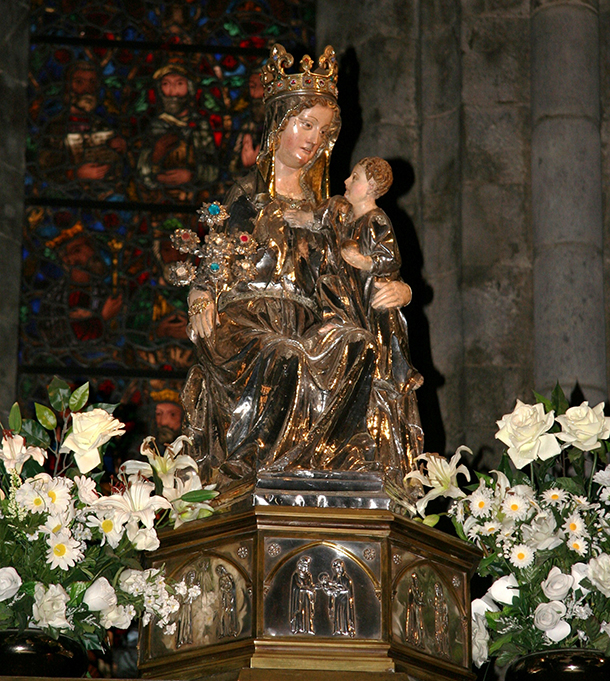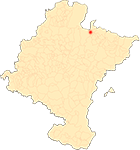Roncesvalles
By Javier Martínez de Aguirre Aldaz
Image of Santa María de Roncesvalles
The seated statue of Saint Mary of Roncesvalles stands out as one of the most interesting pieces of European Marian imagery of its time and a masterpiece among southern carvings. It deserves special praise for its compositional complexity, the gestural intensity of the figures, the interest in manifesting the mother-child relationship, together with the technical mastery both in the treatment of the wood and in its silver coating.
It is easy to appreciate the progress with respect to the Romanesque tradition, in which Mary, impassive, served as Jesus' throne in compositions characterised by frontality and symmetry. In the present work, the Child climbs onto his mother's knees in an impulsive movement, while Mary turns her head and bends it slightly to look at him. Equally remarkable is the expressiveness and humanisation of both figures. The motherly gaze, with its almond-shaped eyes, and the lively gesture of Jesus, treated as befits the age he represents. The artist's quality is evident in the treatment of the folds, especially in the Virgin's garments, which fall with grace and plasticity. Five figures in relief adorn the throne: St. Michael defeating the dragon flanked by St. Peter and St. Paul at the back, and two ceroferary angels on each side, all framed by three-lobed pointed arches.
On the registration at the bottom of the seat we read: ...IT FIERI THOLE AD HO... The word Thole has been interpreted as an abbreviation of Toulouse, presumably the place where the image was made. The appearance of the combination of the seated Virgin and Child standing upright at the beginning of the 14th century and the artistic decline of Toulouse in the second half of the same century led Fernández-Ladreda to suppose that the second quarter or the middle years of that century would be the appropriate chronological framework for its production. At that time Roncesvalles was recovering from a fire, which may have encouraged the construction of the Gothic cloister and the Chapel of San Agustín, as well as the execution of a new titular image for the church of Santa María.
Dectot, X., "Yacente de Sancho VII el Fuerte", in Bango Torviso, I.G. (dir. cient.), Sancho el Mayor y sus herederos. El linaje que europeizó los reinos hispanos, Pamplona, 2006, pp. 371-373.
Fernández-Ladreda, C., Imaginería medieval mariana en Navarra, Pamplona, 1989.
Fernández-Ladreda, C. (Dir.), Martínez Álava, C., Martínez de Aguirre, J. and Lacarra Ducay, M.C., El arte gótico en Navarra, Pamplona, 2015.
Fuentes y Ponte, J., report histórica y descriptiva del santuario de Nuestra Señora de Roncesvalles, Lérida, 1880.
García Gainza, M.C., Orbe Sivatte, M. and Domeño Martínez de Morentin, A., Catalog Monumental de Navarra IV**. Merindad de Sangüesa, Pamplona, 1992.
Ibarra, J., History of Roncesvalles. Art. History. Legend, Pamplona, 1936.
Lambert, E. Roncevaux", Bulletin Hispanique, XXXVII (1935), pp. 417-436.
Martínez de Aguirre, J. (coord.), Enciclopedia del Románico en Navarra, Aguilar de Campoo, 2008, vol. III, pp. 1216-1224.
Martínez de Aguirre, J., Gil Cornet, L. and Orbe Sivatte, M., Roncesvalles. Hospital and sanctuary on the Camino de Santiago, Pamplona, 2012.
Miranda García, F. and Ramírez Vaquero, E., Roncesvalles, Pamplona, 1999.
Peris, A., "El Ritmo de Roncesvalles: estudio y edición", Cuadernos de Filología Clásica. Latin Studies, 11 (1996), pp. 171-209.
Pons Sorolla, F., "project de obras de restauración en la capilla del Sancti Spiritus de la Real Colegiata de Roncesvalles (Navarra)", Príncipe de Viana, XXXIX (1978), pp. 59-77.
Soria i Puig, A., The Road to Santiago. II. Stations and signs, Madrid, 1992.
Torres Balbás, L. La iglesia de la hospedería de Roncesvalles", Príncipe de Viana, VI (1945), pp. 371-403.
Thuile, J., L'Orfèvrerie en Languedoc du XIIe au XVIIIe siècle. Généralité de Montpellier, Montpellier, 1966.












